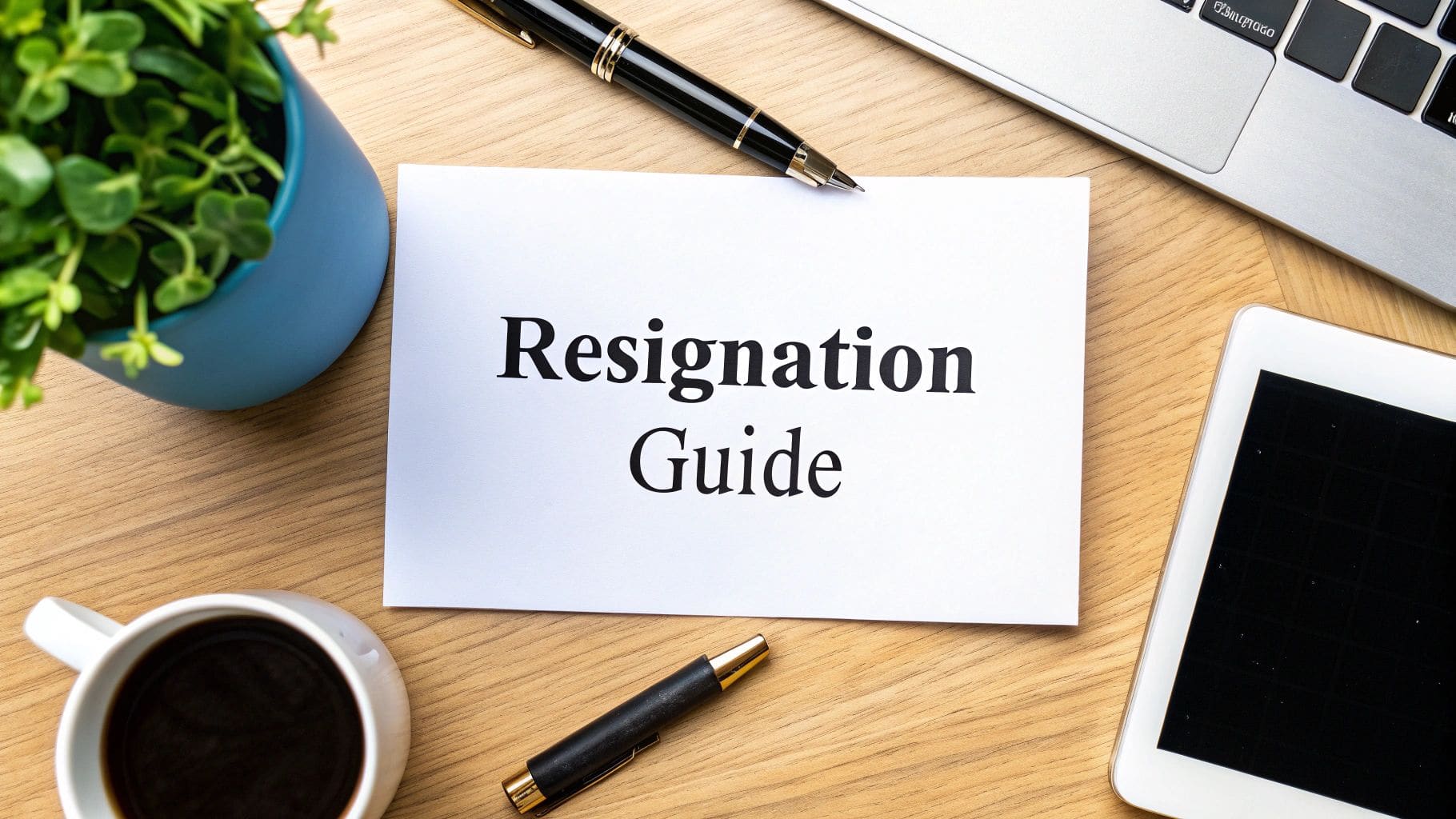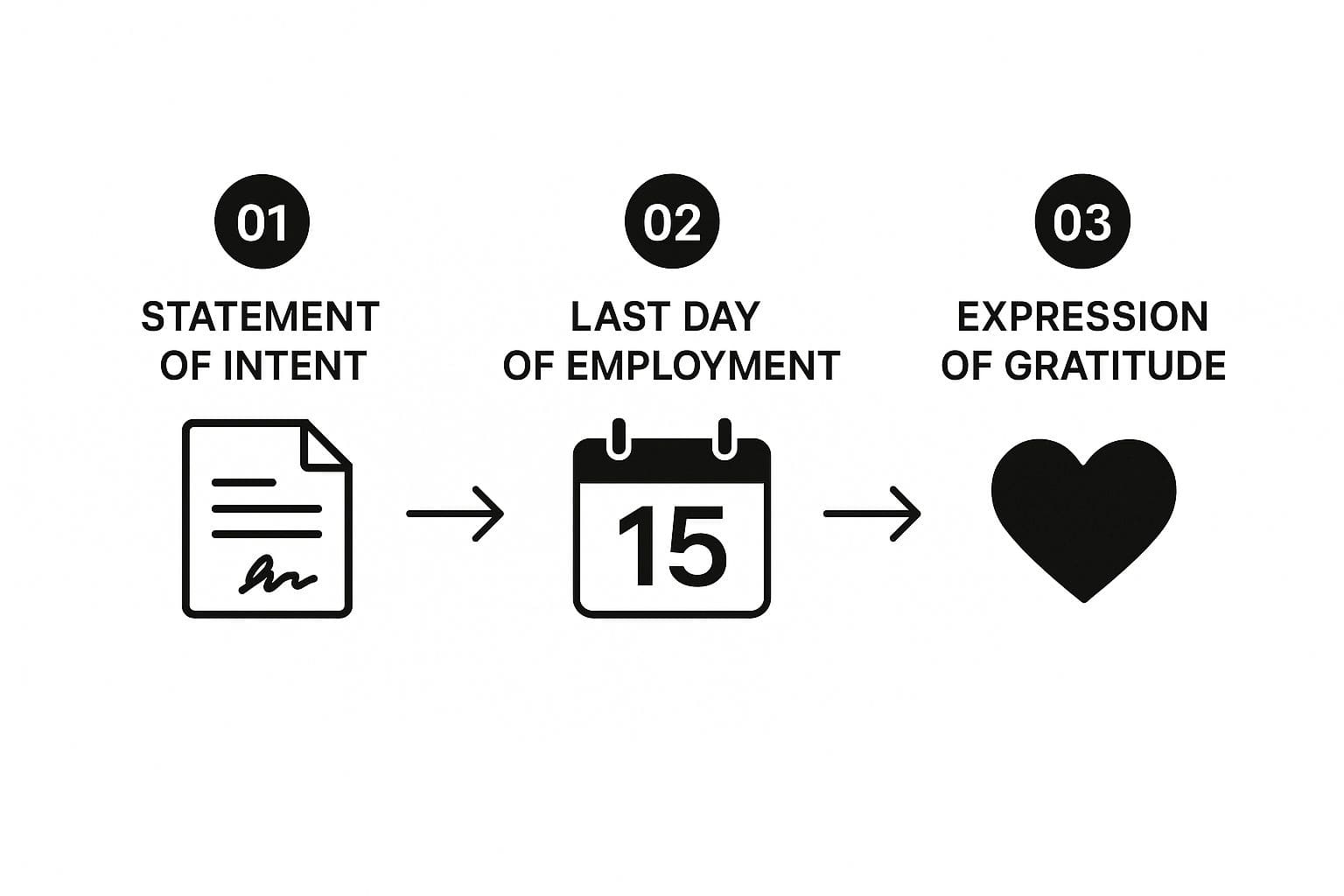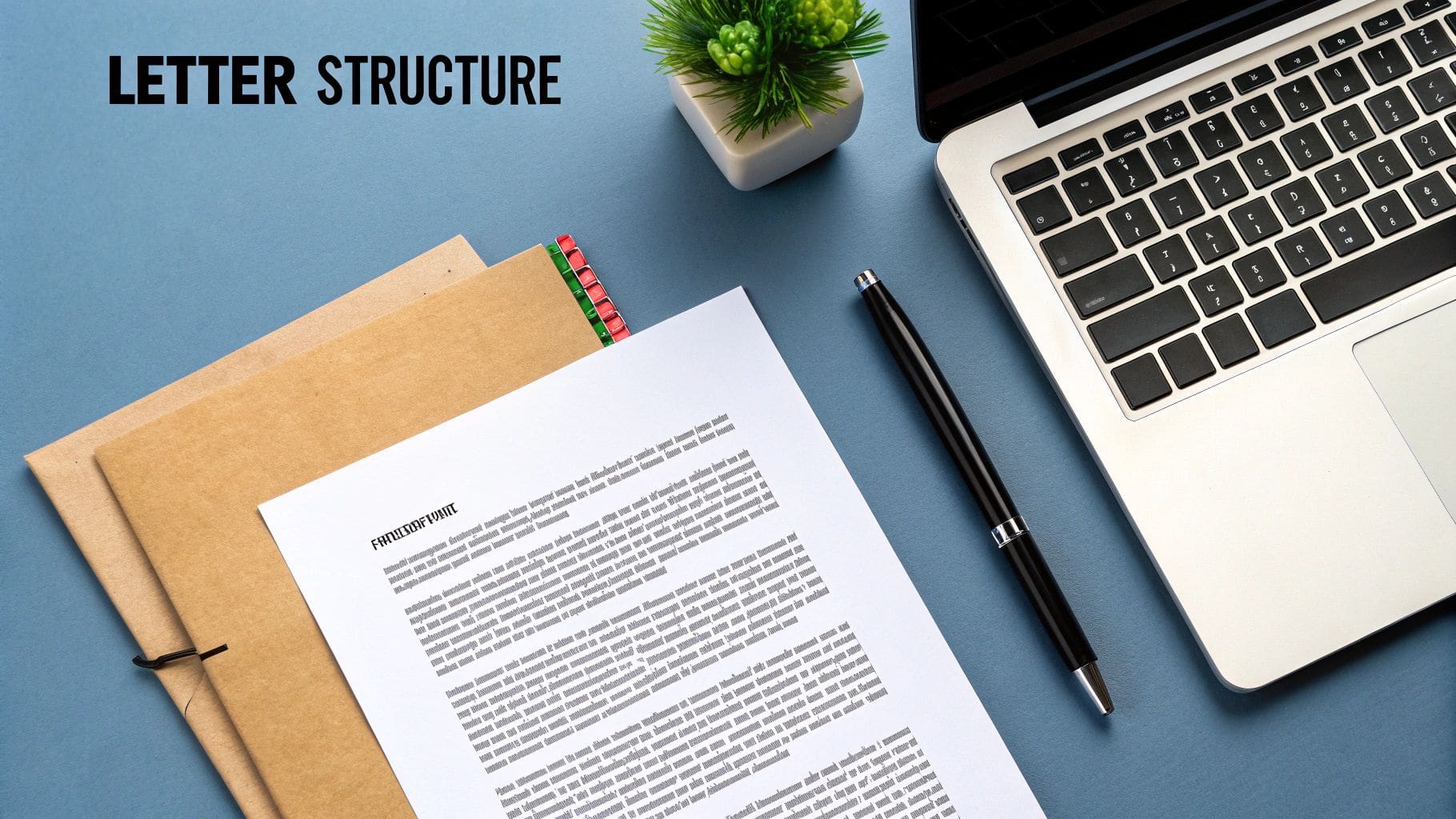Your Professional Letter of Resignation Letter Guide
Craft a perfect letter of resignation letter with this guide. Get practical tips and templates to leave your job professionally and maintain relationships.

Your Professional Letter of Resignation Letter Guide
Crafting a professional letter of resignation letter is more than just an official notice—it's your last formal impression. This strategic document confirms your departure, sets your final day, and, most importantly, keeps your professional reputation intact. When you write a clear and respectful letter, you ensure a smooth, positive exit, leaving the door open for future networking and references. It's your chance to finalise your time at the company on the best possible terms.
What Every Resignation Letter Must Include
Before you put pen to paper (or fingers to keyboard), remember this: your resignation letter will live in your employee file forever. The goal is to be clear, professional, and positive, no matter why you're leaving. A great letter is built on a few key pieces that show respect and prevent any confusion down the road.
This infographic really nails the essential flow, showing how each part connects to create a polished, professional message.

This simple structure—state your intent, provide the timeline, and show appreciation—is the foundation of a letter that leaves everyone on good terms.
The Core Components
First, get straight to the point. Your letter must clearly state that you are resigning. Ambiguity is your enemy here. A direct statement like, "Please accept this as my formal notification of resignation" is all you need. It's confident, respectful, and leaves no room for misinterpretation.
Next, you have to lock in your last day. This is probably the most crucial detail in the entire letter. Providing a specific date—typically two weeks from the date you submit the letter—is non-negotiable. It gives your manager a clear timeline to start planning the handover.
Your resignation letter is not the place for complaints or long-winded explanations. Its only job is to inform, not to vent. A concise, forward-looking document will always serve your career better in the long run.
For a quick summary of what absolutely needs to be in your letter, this table breaks it down.
Quick Guide to Resignation Letter Essentials
| Component | Why It's Important | Example Language |
|---|---|---|
| Clear Statement of Resignation | Removes ambiguity and officially starts the process. | "Please accept this letter as formal notification that I am resigning from my position..." |
| Your Last Day of Employment | Provides a concrete timeline for the transition period. | "...my last day of employment will be [Your Last Day]." |
| Expression of Gratitude | Maintains a positive relationship and shows professionalism. | "Thank you for the opportunity to have worked at [Company Name] for the past [Number] years." |
| Offer to Assist with Transition | Demonstrates commitment and leaves a lasting good impression. | "I am happy to assist in training my replacement to ensure a smooth handover." |
This simple checklist ensures you cover all the essential bases for a professional and effective resignation.
Setting a Positive Tone for Your Departure
Once the formalities are out of the way, a brief note of gratitude is a professional courtesy that goes a long way. You don't need to write a novel. A simple sentence thanking the company for the experience is plenty.
If you want to add a personal touch, mention a specific skill you gained or a project you enjoyed working on. Just like when crafting professional cover letters, a little sincerity makes a huge difference.
Finally, wrap things up by offering to help with the transition. This is a powerful move that shows you're committed to your responsibilities right up to the end. A simple offer like, "I am happy to assist in training my replacement and ensuring a smooth handover of my duties," reinforces your professionalism. It's the final touch that solidifies your reputation, keeping the door open for future networking and great references.
Get your free CV review
Upload your CV and get instant AI suggestions to improve your chances
How to Structure Your Resignation Letter
A well-structured resignation letter isn't just a formality; it's a mark of professionalism that makes your intentions crystal clear. Think of it less like a dramatic farewell and more like a standard piece of business communication. Each section has a specific job to do, guiding your manager through the announcement logically and respectfully.
The whole point is to be direct without being cold or abrupt. From your first sentence to your sign-off, every part of the letter should contribute to a positive, professional final impression.

The Opening Statement
Your first paragraph needs to be straightforward and get right to the point. This isn't the place for a long-winded intro; you need to clearly state that you're resigning and give your final day of employment.
Here's an example of how to phrase it:
- "Please accept this letter as my formal notification of resignation from my position as [Your Job Title] at [Company Name]. My last day of employment will be [Your Last Day], two weeks from today."
This clarity is crucial. It gives your employer the most essential information right away and sets a professional tone for the rest of the letter.
The Body Paragraphs Expressing Gratitude
The middle of your letter is where you can add a bit of warmth. Take a moment to thank your employer for the opportunity they gave you. Mentioning something specific you learnt or a project you enjoyed makes the message feel genuine and personal.
You could write something like this:
- "Thank you for the opportunity to have worked here for the past [Number] years. I've particularly valued my experience leading the [Project Name] initiative and have learnt a great deal about [Specific Skill]."
This small gesture shows you valued your time there, which goes a long way in keeping the relationship positive. It's the same principle you'd use when you learn more about crafting a professional cover letter; a little bit of sincerity and personalisation makes a huge difference.
Pro Tip: Keep your thank you short and specific. A single, thoughtful sentence about a great experience is far more powerful than a paragraph of vague praise. It shows you've actually reflected on your time with the company.
Offering to Assist with the Transition
Right after expressing your thanks, it's a good idea to offer to help with the handover. This shows your commitment to the team's success, even as you're on your way out. It's a simple but significant act of professionalism.
Make sure your offer is clear and realistic. For instance:
- "I am committed to ensuring a seamless transition and am happy to assist in training my replacement and documenting my current projects over the next two weeks."
This proves you're a responsible team player right up until your very last day.
The Professional Closing
Finally, wrap up your letter of resignation letter with a professional closing. A polite sign-off followed by your signature and typed name is all you need. Simple and classic is the best way to go.
Good options include:
- Sincerely
- Best regards
- Respectfully
Leave a little space for your handwritten signature (if you're handing in a hard copy), and then type your full name underneath. This formal closing ties everything together, leaving a final impression of polish and respect.
Finding the Right Tone and What to Avoid

The words you choose for your resignation letter are important, but the tone behind them is what leaves a lasting mark. Think of it less as an exit announcement and more as a final piece of professional correspondence. You're aiming for a tone that is direct, respectful, and appreciative all at once.
Even if you're leaving under less-than-ideal circumstances, your goal is to keep things positive and constructive. This letter becomes a permanent part of your employee record, and how you handle your departure can absolutely influence future references and your reputation in the industry.
Maintaining a Professional Tone
Your word choice is everything here. Focus on being gracious and looking forward. Instead of dwelling on any frustrations you might have, shift the focus to the skills you've gained or the positive experiences you've had.
It's about leaving a final impression of polish and maturity. Learning how to sound professional in a document like this shows you can handle sensitive situations with grace—a skill that will serve you well everywhere. This approach keeps the conversation centred on a smooth transition, not on negativity.
Your resignation letter is a formal business document, not a personal journal. Keep your language objective, avoid emotional phrases, and stick to the facts of your departure.
Critical Mistakes to Avoid
The single biggest mistake people make? Using the letter to air their grievances. Never, ever use your resignation letter to complain about your manager, coworkers, or company policies. That's a surefire way to burn a bridge.
If you have constructive feedback, the exit interview is the proper place for that conversation.
Another common pitfall is oversharing why you're leaving. You're not obligated to give a detailed explanation of your next move. A simple, "I've accepted a new opportunity that aligns with my long-term career goals" is more than enough. Going into detail about a higher salary or better perks can easily come across as unprofessional or boastful.
Here are a few hard and fast rules:
- Don't Criticise: Keep any negative opinions about the company or its people to yourself. This isn't the time or place.
- Don't Get Overly Emotional: Avoid language that's either gushy and sentimental or overly excited about leaving. Keep it balanced and professional.
- Don't Make It a Novel: Brevity is key. Your letter should be concise and to the point; three or four short paragraphs are perfect.
The "Great Resignation" saw a staggering 47 million Americans quit their jobs in 2021 alone, pushing companies to pay closer attention to how employees depart. This makes your professionalism more crucial than ever. The same principles of professional communication apply here as they do in your initial application; you can even review a cover letter sample letter to see how tone is carefully managed in other formal documents. A thoughtful, well-toned resignation letter ensures you leave on the best possible terms.
Resignation Letter Examples for Any Situation
A generic, one-size-fits-all template rarely does the job. The right way to write your resignation letter really comes down to the context of your departure and your relationship with your manager and the company.
To help you get it right, I've laid out three distinct, real-world examples you can adapt. Each one is designed for a specific scenario, with a few notes on why it works and how you can make it your own.
The Standard Professional Template
This is your go-to for most corporate or professional environments. It strikes the perfect balance between being polite and direct, covering all the essentials without getting overly personal or emotional. Think of it as the ideal choice when you have a solid, professional relationship with your manager but aren't necessarily close friends.
Example:
[Your Name]
[Your Address]
[Your Phone Number]
[Your Email]
[Date]
[Manager's Name]
[Manager's Title]
[Company Name]
[Company Address]
Dear [Manager's Name],
Please accept this letter as my formal notification of resignation from my position as [Your Job Title] at [Company Name]. My last day of employment will be [Your Last Day], two weeks from today.
Thank you for the valuable opportunities you have provided during my time here. I have particularly enjoyed working on [Mention a Specific Project or Responsibility] and appreciate the support I've received from you and the team.
I am committed to ensuring a smooth transition. I am happy to assist in training my replacement and documenting my current duties over the next two weeks.
I wish you and the company all the best for the future.
Sincerely,
[Your Signature]
[Your Typed Name]
Why It Works: This letter is effective because it's concise, positive, and forward-looking. It clearly states the necessary information, expresses genuine gratitude for a specific experience, and offers concrete help for the transition, reinforcing your professionalism.
The Formal Template for Senior Roles
When you're in a senior position, an executive role, or part of a more traditional industry like law or finance, a more formal tone is often the right call. This version is more structured and a bit less personal, reflecting the higher stakes of the departure. It's all about maintaining a sense of official decorum.
Example:
[Your Name]
[Your Address]
[Date]
[Manager's Name or Appropriate Senior Leader]
[Title]
[Company Name]
[Company Address]
Dear [Mr./Ms./Mx. Last Name],
I am writing to formally tender my resignation from the position of [Your Job Title] at [Company Name], effective [Your Last Day].
I am grateful for the professional and personal development opportunities that I have been afforded during my [Number] years with the company. The experience gained has been invaluable to my career progression.
To facilitate a seamless handover of my responsibilities, I will ensure all relevant projects are fully documented and briefed to the appropriate team members.
I wish [Company Name] continued success.
Respectfully,
[Your Signature]
[Your Typed Name]
The professional landscape is always shifting. Recent research from Universum Global suggests that another wave of resignations is on the horizon, with between 36% and 46% of skilled professionals considering leaving their jobs in 2025. This trend just highlights how important it is to manage your exit with professionalism and grace.
The Warm and Personal Template
If you have a genuinely close and supportive relationship with your manager and team, a slightly warmer and more personal letter is perfectly fine. This approach lets you express heartfelt thanks whilst still ticking all the necessary professional boxes. You're leaving a team, not just a job.
Example:
Dear [Manager's First Name],
This is my formal notice that I'll be leaving my role as [Your Job Title] at [Company Name]. My final day will be [Your Last Day].
This was not an easy decision to make. I am incredibly grateful for the mentorship and support you've given me over the past [Number] years. I'll always value our work on [Mention a Shared Project] and will miss our team's collaborative spirit.
Of course, I'll do everything I can to help with the transition over the next two weeks. Please let me know the best way to start the handover process.
Thank you again for everything. I look forward to staying in touch.
Best regards,
[Your Typed Name]
These examples show how a resignation letter isn't a rigid formula but a flexible tool you can adapt. For more guidance on crafting professional documents, you might find our guide on what to include in a CV letter useful.
What To Do After The Letter Is Sent
So, you've hit "send" on that resignation letter. That's a huge step, but the job isn't quite done. Honestly, how you handle yourself in these next two weeks is what people will remember most. This is your chance to really solidify your professional reputation.
Your main goal now shifts from doing your job to ensuring a seamless handover for the person who will take your place. It's about more than just clearing your to-do list; it's about setting up your team and your successor for success long after you're gone.

The Resignation Conversation: Your First Move
Before that email even goes out, you need to have a real conversation—face-to-face or at least over video—with your direct manager. This isn't just a formality; it's a critical professional courtesy that sets the tone for your entire departure.
Walk into that meeting ready to state your decision clearly and positively. They're going to have questions, so think ahead. Be prepared to confirm your final day and give a brief, professional reason for your departure. The key is to keep it concise and forward-looking, focusing on your new opportunity rather than any negatives about your current role.
Your final impression is a lasting one. Navigating your notice period with grace and professionalism ensures you leave on the best possible terms, preserving relationships that could be valuable for years to come.
Once the conversation is over, you can follow up by formally submitting your letter of resignation letter. Be ready for any kind of reaction, from genuine support to surprise or disappointment. Whatever their response, your job is to stay calm and professional.
Crafting a Transition Plan and Nailing the Exit Interview
Taking the lead on the transition process shows you're a responsible professional right to the very end. Start documenting everything immediately: your key duties, the status of ongoing projects, and who your important contacts are. This document will become an invaluable roadmap for your replacement.
A solid transition plan should probably include things like:
- Project Status Updates: Give a clear snapshot of where all your projects stand, including what the immediate next steps are and any critical deadlines.
- Routine Task Outline: List out the daily and weekly tasks you handle so nothing falls through the cracks.
- Key Contacts List: Provide a simple list of names, roles, and contact info for the main clients, vendors, or internal people your replacement will need to know.
You'll almost certainly be asked to do an exit interview. This is your moment to offer up some genuinely constructive feedback. Don't use it as a chance to air personal grievances. Instead, frame your comments thoughtfully around processes or systems you think could be improved.
The trend of employees leaving their jobs remains a big deal for companies. Whilst the frenzy peaked with nearly 4.5 million monthly quits in late 2021 and early 2022, the numbers are still significant. As of March 2025, quits still hovered around 3.3 million, showing that businesses are constantly navigating employee exits. You can learn more about the Job Openings and Labor Turnover Survey findings on Statista.
Ultimately, a smooth exit, kicked off by a professional resignation document, is your final contribution to the company. By staying engaged and helpful until your very last day, you guarantee that you walk out the door with your reputation shining.
Your Top Resignation Letter Questions, Answered
Once you've made the decision to leave, a whole new set of questions pops up. It's completely normal. You want to handle your exit with grace and professionalism, and getting the official paperwork right is a huge part of that. Let's walk through some of the most common sticking points people run into when drafting their resignation letter.
Should I Send an Email or a Paper Copy?
This is a classic question, and the answer isn't strictly one or the other. The best approach is actually a two-step process that combines professional courtesy with a clear paper trail.
First, always schedule a private chat with your manager to deliver the news verbally. Whether it's in person or over a video call for remote roles, this conversation is a sign of respect. It's the human part of the process.
Immediately after that conversation, you need to make it official.
- For in-office roles: Handing your manager a signed, printed copy of your letter is a traditional and highly professional touch.
- For remote roles: The standard is to send a professional email to your manager with your formal letter attached as a PDF. This creates an immediate, time-stamped record for both you and HR.
This hybrid method gives you the best of both worlds: the personal touch of a direct conversation and the formal documentation every company needs.
Do I Have to Explain Why I'm Leaving?
This one is simple: no, you don't. In fact, you absolutely shouldn't.
Your resignation letter is a formal HR document, not a place for feedback, complaints, or a detailed story about your next adventure. Its only job is to state your intention to resign and confirm your final day of employment.
Keep your letter brief, positive, and to the point. This isn't the time or place for complex explanations. If you have constructive feedback to share, the exit interview is a much better forum for that conversation.
You can mention you're leaving for a "new opportunity," but that's as far as you need to go. Remember, this letter lives in your employee file forever. Keeping it neutral and professional is the smartest move for your long-term career.
How Much Notice Is Really Enough?
The gold standard in almost every industry is two weeks' notice. This is considered professional courtesy and gives your employer a reasonable window to start planning for the transition. It's enough time for them to figure out how to cover your responsibilities and kick off the hiring process for your replacement.
However, don't just assume two weeks is the rule. Before you do anything, check your employment contract or the company handbook. Some senior-level or highly specialised roles might require a longer notice period, like 30 days or even more.
Sticking to the agreed-upon timeframe is non-negotiable if you want to leave on good terms and secure a positive reference down the road.
--- Ready to make your next career move with confidence? The CV Anywhere platform offers a full suite of tools, from a Smart CV Builder to an AI-powered Interview Coach, designed to help you land your next role faster. Start building your future today with CV Anywhere.
Tags
Related Articles
How to Write a Professional Resignation Letter
How to Write a Professional Resignation Letter A professional resignation letter is the official document that begins your departure from a job, serving as your final professional handshake. Its prima...
Read more →How to Write a Professional Resignation Resign Letter
How to Write a Professional Resignation Resign Letter Writing a professional resignation resign letter is the last critical step to leaving your job on good terms. A strong letter is straightforward: ...
Read more →How to Write the Perfect Thank You Email After Interview
Sending a thank you email after interview isn't just about being polite—it's a strategic move that reinforces your value and keeps you top-of-mind whilst hiring decisions are being made. Think of it a...
Read more →Popular Articles
Figuring out how to list your education on a resume is a strategic move. Where you place it is one of the first things a recruiter's eyes will land on, and you've got about seven seconds to convince t...
Using an ATS resume template means designing a CV for a robot's eyes first. It's a clean, straightforward document created specifically to be read and understood by Applicant Tracking Systems (ATS). B...
To get your ATS friendly CV UK employers will actually see, you need a CV that's simple, predictable, and incredibly easy for software to read. Applicant Tracking Systems (ATS) are software, not peopl...
Crafting a compelling post grad resume when you're fresh out of uni can feel like a catch-22. You need experience to get a job, but you need a job to get experience. The secret is that your resume isn...
Using an ATS CV checker UK tool is one of the smartest moves you can make to ensure your application gets seen by a recruiter. With most companies now using Applicant Tracking Systems (ATS) to filter ...